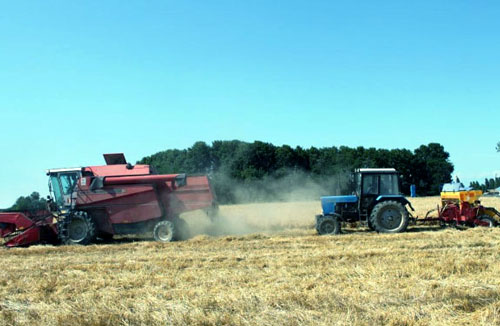 Conservation agriculture methods enable producers to sustainably intensify production, improve soil health, and minimize or avoid negative externalities. However, these practices have not yet taken off in most Central Asian countries. The FAO Sub-Regional Office for Central Asia, in cooperation with CIMMYT, ICARDA, and the national counterparts, conducted a study on the status of conservation agriculture in Central Asia to develop policy recommendations for its promotion. The document titled “Conservation Agriculture in Central Asia: Status, Policy, Institutional Support, and Strategic Framework for its Promotion” presents the existing opportunities for adoption and uptake of conservation agriculture techniques, as well as the conditions that need to be taken into account in designing and promoting policy and institutional support strategies for its up-scaling.
Conservation agriculture methods enable producers to sustainably intensify production, improve soil health, and minimize or avoid negative externalities. However, these practices have not yet taken off in most Central Asian countries. The FAO Sub-Regional Office for Central Asia, in cooperation with CIMMYT, ICARDA, and the national counterparts, conducted a study on the status of conservation agriculture in Central Asia to develop policy recommendations for its promotion. The document titled “Conservation Agriculture in Central Asia: Status, Policy, Institutional Support, and Strategic Framework for its Promotion” presents the existing opportunities for adoption and uptake of conservation agriculture techniques, as well as the conditions that need to be taken into account in designing and promoting policy and institutional support strategies for its up-scaling.
The challenges facing the dissemination and adoption of conservation agriculture practices in the region include development of enabling government policies and institutional environment to mainstream conservation agriculture, changing the farmers’ tillage mind-set, training to operate conservation agriculture equipment, and availability and accessibility of suitable implements. However, the authors believe that there is a great potential to revitalize the withered economies of Central Asian countries via improved productivity and higher total output through conservation agriculture based agricultural development. Kazakhstan, the only country that has actively embraced conservation agriculture, provides great evidence for such claims. With the support of CIMMYT, FAO, ICARDA, the World Bank, the Ministry of Agriculture of Kazakhstan, and other international organizations and donors, Kazakhstan began adoption of conservation agriculture practices in 2000; by 2012 there were 2 million hectares —13% of the country’s wheat growing area— under conservation agriculture. According to the FAO Investment Center mission to Kazakhstan, the adoption of zero tillage and conservation agriculture had raised domestic wheat production by almost 2 million tons, which equals some US$ 0.58 billion more income over 2010-12, enough grain to satisfy the annual cereal requirements of almost 5 million people, and the sequestering of about 1.8 million additional tons of CO2 per year. CIMMYT’s work in Kazakhstan demonstrates that the challenges facing Central Asia regarding conservation agriculture can be overcome. “The main achievement of CIMMYT in Kazakhstan has been the changing of the minds of farmers and scientists,” observes Bayan Alimgazinova, head of the Crop Production Department of KazAgroInnovation. Auyezkhan K. Darinov, president-chairman of the Republic Public Union of Farmers of Kazakhstan adds: “Kazakhstan is now the most experienced in conservation agriculture in Central Asia.” Hopefully, the practices and experience will spread to other Central Asian countries seeking to ensure food security.
For the full FAO report: Conservation Agriculture in Central Asia: Status, Policy, Institutional Support, and Strategic Framework for its Promotion.
For more information on conservation agriculture in Kazakhstan: Water-saving techniques salvage wheat in drought-stricken Kazakhstan.
 Innovations
Innovations